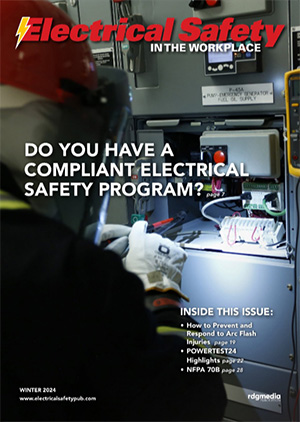How to Establish an Electrically Safe Work Condition
By Jason Moore, Contributor
 The Control of Hazardous Energy (CoHE) in general industry was the fourth most frequently cited OSHA standards violation in FY 2019. While it is the obligation of the employer to establish, document, and implement a lockout/tagout (LOTO) program and provide appropriate equipment to properly control all sources of hazardous energy, every qualified worker has a critical responsibility to ensure control of these energies while establishing an electrically safe work condition.
The Control of Hazardous Energy (CoHE) in general industry was the fourth most frequently cited OSHA standards violation in FY 2019. While it is the obligation of the employer to establish, document, and implement a lockout/tagout (LOTO) program and provide appropriate equipment to properly control all sources of hazardous energy, every qualified worker has a critical responsibility to ensure control of these energies while establishing an electrically safe work condition.
NFPA 70E Article 120 Establishing an Electrically Safe Work Condition, OSHA CFR 1910.147 The Control of Hazardous Energy (Lockout/Tagout) and ANSI Z244.1 Control of Hazardous Energy Lockout/Tagout and Alternative Methods detail the responsibilities and processes for sequestering energy sources. Essential common denominators found in these three documents involve planning and involvement.
Planning
Lockout/tagout begins with planning—a critical step in proper control. It is crucial that a qualified worker knowledgeable with the equipment plans the LOTO activity. Thorough review of one-line diagrams, confirmation of equipment ID tags, as well as power source information labels—which should be found on each isolation point—are necessary to begin this process. A qualified person should thoroughly walk through the proposed LOTO process while ensuring all points of isolation are properly identified, aligned with the one-line diagrams, and indisputably the only sources of hazardous energy associated with the equipment to be put into an electrically safe work condition.
Any noted omittance of equipment labeling or observed errors must be promptly corrected prior to proceeding with the LOTO process. While this article highlights the electrical component of a safe work condition, it is significant that readers also recognize that the planning process for LOTO often includes the identification of isolation points associated with other forms of hazardous energy. These too must be confirmed, and the written plan must systematically organize all points ensuring each point is isolated in the proper order.
Once the plan is accurately documented and management approval obtained, the load current(s) are to be interrupted, and a qualified person will open the disconnecting device for each source. Whenever possible, visual verification of this equipment in the “open” position should be made. For disconnect switches, the knife blades should be confirmed to be “open.” For draw out-type circuit breakers, visual verification must ensure they are properly withdrawn to the “test” or fully disconnected position. With these hazardous energies isolated any other sources of stored electrical energy must be released. Additionally, all remaining non-electrical energy are blocked or relieved to the extent that circuit parts cannot be unintentionally energized by such devices.
 Discrepancy Among Organization Guidelines
Discrepancy Among Organization Guidelines
A key discrepancy in practice guidelines exists between OSHA and NFPA regarding achieving a zero-energy state and applying locks/tags. OSHA CFR 1910.147 details their process as the isolation of energy sources, application of locks/tags to these devices, followed by the release of any stored or other types of energy using stored energy controls. NFPA 70E Section 120.5 prescribes the isolation of energy sources, with subsequent release of any stored or other types of energy followed by the application of locks/tags. OSHA’s document is a Code of Federal Regulations (CFR) is enforceable but is not updated on a frequent basis. NFPA is considered the consensus standard and is updated on a much more frequent schedule (every three years). In the experience of the author, the guideline identified by NFPA is more widely applied.
Absence of Voltage
With all sources properly isolated, LOTO devices are to be applied in accordance with the energy control program. An adequately rated portable test instrument is used to test for the absence of voltage. In lieu of the traditional handheld voltage meter, NFPA 70E – 2021 edition provides an exception allowing the use of an adequately rated permanently mounted absence of voltage tester (AVT), provided it meets the following requirements:
- It is permanently mounted and installed in accordance with the manufacturer’s instructions and tests the conductors and circuit parts at the point of work.
- It is listed and labeled for the purpose of testing for the absence of voltage.
- It tests each phase conductor or circuit part both phase-to-phase and phase-to-ground.
- The test device is verified as operating satisfactorily on any known voltage source before and after testing for the absence of voltage.
For instances where the possibility of induced voltages or stored electrical energy exists, all circuit conductors and circuit parts must be grounded before they are touched.
Associated and Adjacent Machines
While this process is necessary to reach a zero-energy state on the primary machine/process where work is to occur, consideration must also be given to possible energy sources for associated and/or adjacent machines. Associated machines interface with the primary machine, but their power is not derived from the primary equipment. Adjacent machines may not be associated with the primary machine, but by proximity may present a hazard to persons working on the primary machine. Thorough planning should identify these hazards and isolate their energy sources as needed to allow for a safe work condition.
Involvement is Everyone’s Responsibility
The establishment of an electrically safe work condition requires the involvement of all stakeholders. From the employer to the employee or contractor, all persons affected or qualified and performing the work of the energy control procedure must be fully invested toward complete control of all electrical and other hazardous energies. Electrical conductors and circuit parts are considered energized until the process of establishing an electrically safe work condition is complete. The appropriate PPE must be worn throughout this process.
Auditing
Processes, equipment, personnel, and other factors can change over time. ANSI, NFPA, and OSHA require the auditing of these written instructions to maintain their integrity and to ensure a safe work environment. The key consistency amongst these standards is that this auditing task is to be performed by an authorized person other than the one(s) utilizing the energy control procedure being inspected. ESW
Jason Moore is the Electrical Safety Mitigation Specialist for Thompson, focused on mitigation of electrical hazards; arc flash, coordination, and short-circuit studies; as well as electrical safety training to promote a safer work environment for customers across North America (www.thompsonknows.com).
Share on Socials!
NFPA 70E® 2021 for Electrical Safety in the Workplace®
Electrical Hazards in Solar Photovoltaic (PV) Systems
Before You Get Started: Things to Consider in Low-Voltage Work
Leaders in Electrical Safety
• Aramark
• Bowtie Engineering
• Enespro
• Ericson
• I-Gard Corporation
• IRISS
• KERMEL, INC.
• Lakeland Industries
• MELTRIC Corporation
• National Safety Apparel
• National Technology Transfer
• Oberon
• Saf-T-Gard
• SEAM Group
Subscribe!
Sign up to receive our industry publications for FREE!







